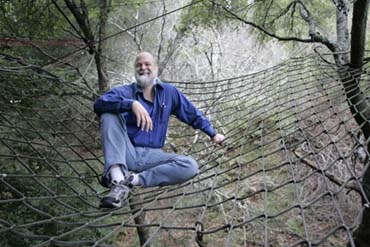What Snail Is This?
While walking at Mountain View's Shoreline Park I came across a type of land snail I had never seen before.
At first I thought it was a common European Brown Snail that was somehow bleached white or covered with some kind of salt deposit. Shoreline Park is, after all, at the shore. But after close examination I became convinced that this was a different type of critter altogether. It was naturally whiter than the snails I was used to seeing farther inland, and seemed a bit flatter (less pointed), and inside, it had a dark stain on the shell.
After some searching on the web, I tentatively identified it as possibly a Milk Snail (Otala lactea). Readers who view the photos and have a positive identification are eagerly invited to send me email or comment on this article.
But as most web searches do, this one led to more questions, and more browsing. Many sources mentioned the introduction of the European Brown Snail (Cantareus aspersus) to California by a Frenchman in or around 1850. Others disagreed, or had variously different versions of the story. But nowhere could I find information on who the Frenchman was, or a definitive source for the story.
I often ask my friends at Google for examples of things that are difficult to find using a web search. This has become something of a game. So here was one example staring me in the face. Who started the story about the Frenchman importing escargot to California, only to end up dumping them into a river?
The story seems to be one of those where you can tell it is suffering from "telephone game" distortions after being told too many times. Once source claims the snails were dumped in the Santa Clara River in Northern California. But that river is in Southern California. Another source claims that if San Franciscans wouldn't eat them, he concluded no one would. Another says the market for snails during the Gold Rush was "too unsophisticated" to eat common garden pests.
One reference in Google Books cites an author Forbes writing in 1850, and another, Stearns, writing in 1900. It is this last reference where I hit pay dirt.
Robert Edwards Carter Stearns (1827-1909) tells of a Mr. A. Delmas, of San Jose, California, who brought a stock of European Brown snails to a vineyard on the west bank of the Guadalupe river in the Santa Clara valley (what we now call "Silicon Valley"). Stearns notes that the valley was settled by "a few French families", and that the introduction of the snail was 'with an eye to the pot'. By 1900, the snails had crossed the river to the east side, and were becoming a nuisance in gardens.
The snails were also planted in San Francisco and Los Angeles by the elder Mr. Delmas, but Stearns could not find any in San Francisco, concluding that the weather and drifting sands in that city in 1860 would be inhospitable. Things had changed by 1900, and he thought they would "find a congenial environment in Golden Gate Park" if they were ever brought there. They were already a problem in Oakland at that time, and in Elysian Park in Los Angeles.
It is now about 150 years after Mr. Delmas released the critters in San Jose. There seem to be few places I have visited in California where they are not a common garden pest, if you live in a city. Where I live, a few miles away from San Jose, they are absent -- I live on a mountain, surrounded by steep dry hills. But in the houses at the base of the mountain, a constant battle between mollusc and man goes on.

1 Comments:
Even though I love escargot, I have never been motivated enough to try to make my own with garden snails. Plenty of how-to's out there, but the idea oddly grosses me out. Have you ever made your own escargot?
Great story, Simon!
Post a Comment
Links to this post:
Create a Link
<< Home